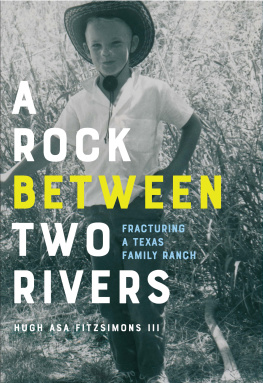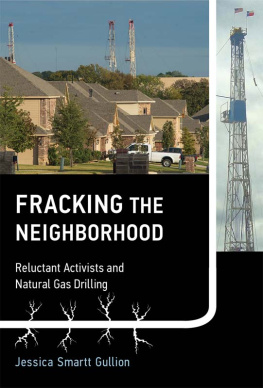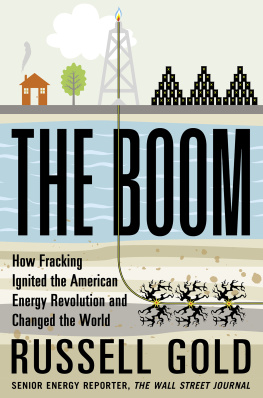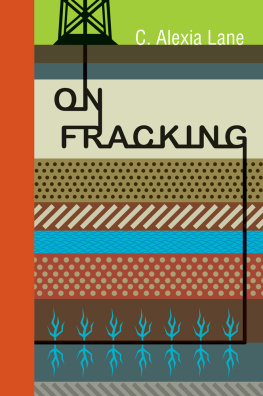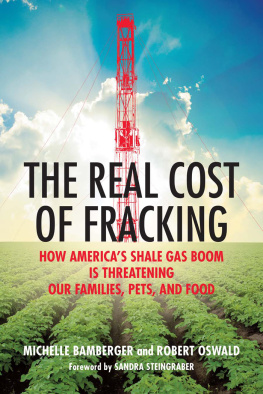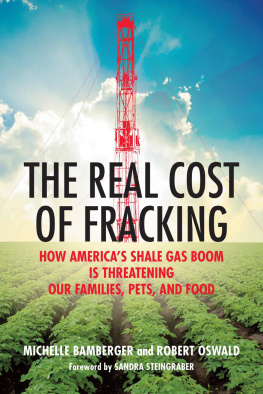The David Suzuki Institute is a non-profit organization founded in 2010 to stimulate debate and action on environmental issues. The Institute and the David Suzuki Foundation both work to advance awareness of environmental issues important to all Canadians.
We invite you to support the activities of the Institute. For more information please contact us at:
David Suzuki Institute
219 2211 West 4th Avenue
Vancouver, BC, Canada VK 4S2
info@davidsuzukiinstitute.org
604-742-2899
www.davidsuzukiinstitute.org
Cheques can be made payable to The David Suzuki Institute.
Andrew Nikiforuk
SLICK
WATER
Fracking and One Insiders
Stand Against the Worlds
Most Powerful Industry
Vancouver/Berkeley
Doreen Dochertymy profile in courage.
Copyright 2015 by Andrew Nikiforuk
All rights reserved. No part of this book may be reproduced, stored in a retrieval system or transmitted, in any form or by any means, without the prior written consent of the publisher or a license from The Canadian Copyright Licensing Agency (Access Copyright). For a copyright license, visit www.accesscopyright.ca or call toll free to 1-800-893-5777.
Greystone Books Ltd.
www.greystonebooks.com
David Suzuki Institute
2192211 West 4th Avenue
Vancouver, BC, Canada V6K 4S2
Cataloging data available from Library and Archives Canada
ISBN 978-1-77164-076-3 (cloth)
ISBN 978-1-77164-077-0 (epub)
Editing by Barbara Pulling
Cover design by Nayeli Jimenez
Cover photograph by iStockphoto.com

We gratefully acknowledge the financial support of the Canada Council for the Arts, the British Columbia Arts Council, the Province of British Columbia through the Book Publishing Tax Credit, and the Government of Canada through the Canada Book Fund for our publishing activities.
The arc of the moral universe is long, but it bends toward justice.
MARTIN LUTHER KING, JR.
The Orwell law of the future: any new technology that can be tried will be. Like Adam Smiths invisible hand (leading capitalist economies toward ever-increasing wealth), Orwells Law is an empirical fact of life.
DAVID GELERNTER, The Second Coming: A Manifesto, Edge, 1999
Thousands have lived without love, not one without water.
W. H. AUDEN, First Things First
CONTENTS
PROLOGUE
AT THE BEGINNING of the American Civil War, the humorist Mark Twain trekked to Nevada, where he tried his hand at mining. Like most fortune seekers, Twain hoped to become a nabob living flush times. But Twain lost money and failed miserably at getting rich. Shortly afterward, the writer coined a new definition for mining: a hole in the ground with a liar on top.
Scholars now debate whether Twain made the remark. Some suggest the quote may have originated with a man from Kansas. But the definition stuck and has been used ever since, because it remains an apt description of mining.
This book is an unconventional true story about a new form of disruptive mining: hydraulic fracturing.
ONE
The Dress for Less Explosion
ON THE AFTERNOON of March 24, 1985, the Ross Dress for Less clothing store at West 3rd and Ogden in the Fairfax District of Los Angeles blew up into an inferno. A spark from somewheremost likely a janitor flicking a basement switchignited an invasive cloud of methane with a hellish boom. The explosion ripped up concrete slabs, blew out windows, singed cars, and cracked walls. Fire belching fissures opened in the ground. The conflagration injured twenty-three shoppers, some of whom suffered third-degree burns. It also forced the evacuation of twenty to thirty stores along a quarter-mile commercial strip. One witness said the sky was raining fire. Another compared the disaster to an earthquake. Out of nowhere the room exploded, a shopper told a TV news crew, and I was thrown to one side. For days, escaping plumes of methane gases licked the foundations of buildings and sidewalk cracks. Firefighters tried in vain to extinguish the flames.
The explosion did more than rattle the residents of Los Angelesit inaugurated the continents first debate about hydraulic fracking, horizontal drilling, and migrating gases. The oil and gas industry blamed the explosion on bacteria and naturally seeping gases. Scientists, however, reckoned differently. They identified hydraulic fracturing and abandoned leaky oil wells as the chief suspects.
Like any good detective tale, the Dress for Less story begins in an earlier time: Californias black gold rush. In the early 1900s, wooden oil derricks popped up so fast in Los Angeles that streets looked like a surreal forest painted by Picasso. Some two hundred oil companies drilled more than two thousand wells into scores of different oil fields. The frenzy turned the city into a vibrant oil-soaked little canyon. Early homeowners gamely hosted wooden derricks in their backyards and disposed of oil-field waste in their basements. Oil wells planted in cemetery plots allowed the dead to provide income for the living, in the form of royalty checks. The thirty-year-long boom manufactured big fortunes for Union Oil, Getty Oil, and Atlantic Richfield. The flowing oil dollars in turn fueled the states Wild West car culture and enriched evangelical churches. Petrodollars supported the upstart film industry and a raft of corrupt real estate deals. Oil turned California into an early American Kuwait.
The oil frenzy produced some memorable characters, just as the shale gas boom would do one hundred years later. A religious piano teacher named Emma Summers became Californias Oil Queen thanks to her genius for affairs. She made millions selling oil to local hotels and industry. A dairy farmer, Arthur F. Gilmore, discovered black gold in the Salt Lake Oil Field in 1902 while looking for water. The field, which occupied an area about one mile by two miles, soon became the highest-producing formation in California. By 1917, more than four hundred wells had extracted an astounding 50 million barrels of oil from the highly faulted field, where tar seeped to the surface at Rancho La Brea. Gilmore got rich from his find and started his own oil company, advertising, Someday you will own a horseless carriage. Our gasoline will run it. Gilmore Oil later pioneered the original gas-a-teria, the first pump-your-own gas station.
After Gilmores oil wells started to go dry in the 1930s, a farmers market and a stadium arose on top of the Salt Lake Oil Field and its abandoned oil wells, sump pits, and oil spills. The citys restless economy planted another crop of buildings on the site as well, including the famous CBS Television City and a shopping center. No one dreamed of the possible consequences, because an oil-fueled city rarely sleeps.
Nor did the oil industry abandon the citys subterranean oil fields. During the 1960s, many companies reentered the Salt Lake field with horizontal wells or long wells drilled on a slant. To this day, industry extracts 28 million barrels of crude a year from LAs petroleum basement. Land owned by the Archdiocese of Los Angeles sports scores of oil and gas wells, as do several movie lots. Industry disguised the Cardiff pumping station as a synagogue. In a 2010 exhibit on urban crude, LAs Center for Land Use Interpretation revealed that thousands of wells puncture the city like tree roots, extracting the living essence of the ground, fueling this city of the car. Moreover, the exhibit added, industry drains the progenerative substrate by operating in cracks, corners, and edges, hidden behind fences, and camouflaged into architecture, pulling oil out from under our feet.


